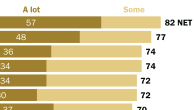This profile provides key demographic information on Latino eligible voters1 and other major groups of eligible voters in Nebraska.2 All demographic data are based on Pew Hispanic Center tabulations of the U.S. Census Bureau’s 2010 American Community Survey.3
Hispanics in Nebraska’s Eligible Voter Population
- The Hispanic population in Nebraska ranks 35th in the nation.4 About 168,000 Hispanics reside in Nebraska, 0.3% of all Hispanics in the United States.
- Nebraska’s population is 9% Hispanic, the 19th largest Hispanic population share nationally.
- There are 63,000 Hispanic eligible voters in Nebraska—ranking 34th in Hispanic eligible voter population nationally. California ranks first with 5.9 million.
- Some 5% of Nebraska eligible voters are Hispanic, ranking the state 34th in Hispanic eligible voter share nationally. New Mexico ranks first with 39%.
- More than one-third of Hispanics in Nebraska (38%) are eligible to vote, ranking Nebraska 28th nationwide in the share of the Hispanic population that is eligible to vote. By contrast, more than three-quarters (77%) of the state’s white population is eligible to vote.

Characteristics of Eligible Voters
- Age. More than one-third of Hispanic eligible voters in Nebraska (35%) are ages 18 to 29, slightly greater than the share of all Latino eligible voters nationwide (33%) in that age range. By contrast, only 22% of all Nebraska eligible voters and of all U.S. eligible voters are ages 18 to 29.
- Citizenship and Nativity. Among Hispanic eligible voters in Nebraska, 27% are naturalized U.S. citizens. This compares with 25% of Hispanic eligible voters in the U.S., but just 3% of all eligible voters in Nebraska and 8% of eligible voters in the U.S overall.
- Hispanic Origin. Hispanic eligible voters in Nebraska have a different Hispanic origin profile from Hispanic eligible voters nationwide. About eight-in-ten (81%) Hispanic eligible voters in Nebraska are of Mexican origin, 3% of Puerto Rican origin and 16% claim other Hispanic origin. Among all Hispanic eligible voters nationwide, six-in-ten (59%) are Mexican, 14% are Puerto Rican and about one-quarter (26%) are of some other Hispanic origin.
- Educational Attainment. One-third of Latino eligible voters in Nebraska (33%) have not completed high school, about four times the 8% of all Nebraska eligible voters who have not completed high school.
- Homeownership. About six-in-ten Hispanic eligible voters in Nebraska (61%) live in owner-occupied homes compared with 58% of all Hispanic eligible voters nationwide. Greater shares of all eligible voters in Nebraska (70%) and all eligible voters nationwide (69%) live in owner-occupied homes.

Characteristics of Eligible Voters in Nebraska, by Race and Ethnicity
- Number of Eligible Voters. White eligible voters outnumber Hispanic eligible voters in Nebraska by more than 18 to 1. There are more Hispanic eligible voters (63,000) than black eligible voters (47,000).
- Age. Latino eligible voters are younger than black and white eligible voters in Nebraska. Some 35% of Latinos are ages 18 to 29, compared with 26% of black eligible voters and 21% of white eligible voters.
- Educational Attainment. Hispanic eligible voters have lower levels of education than do black and white eligible voters in Nebraska. One-third (33%) of Hispanic eligible voters have not obtained a high school diploma compared with 14% of black eligible voters and 6% of white eligible voters.
- Homeownership. Hispanic eligible voters (61%) are more likely to live in owner-occupied homes than black eligible voters (36%) in Nebraska, but they are less likely to do so than white Nebraska eligible voters (72%).





